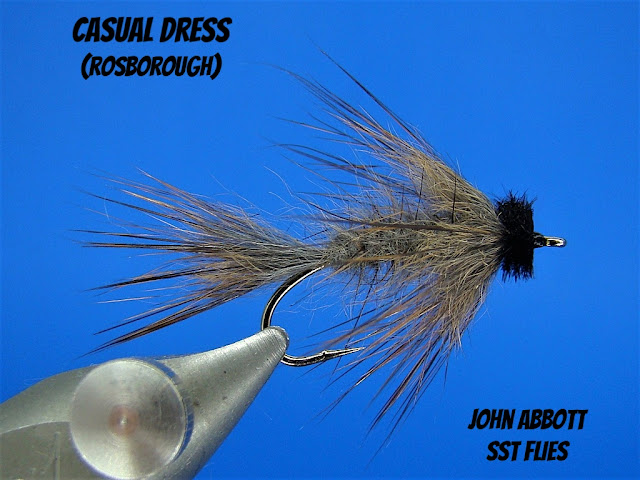We're not headed back in time too far. The year was 1960 when three experimental (Casual Dress) nymphs were introduced to the waters of Oregon's Deschutes River where it enters the Wickiup Reservoir. Long story short the nymphs immediately racked up some pretty impressive catches and E. H. "Polly" Rosborough's nymph continues to find the end of a leader to this day.
I'll be honest... I don't fish this nymph very often in the rivers (where I should probably spend more time doing so) strictly due to the type of water(s) I fish, but in the lakes the fly really shines for me. I am not sure what the fish take it for, perhaps a leech, damsel or dragon fly nymph, but the tail and collar definitely provide enough undulating action that the takes are very hard!
The Casual Dress is suggestive of many aquatic food forms and only requires two materials tie- muskrat and ostrich herl. Rosborough writes, "While is appears to represent some tidbit of very active food, to the fish, it really simulates nothing more than just that, food."
Tying notes: (" " indicates direct quotes Rosborough's Tying and Fishing the Fuzzy Nymphs.
(1) Although Rosborough doesn't specifically mention adding weight to his patterns, you may do so if desired. He does mention "plenty of cement" (varnish) along the thread before the body is wound. I usually weight the forward portion of the hook shank,
(2) Even though the body is spun in a dubbing loop Polly pens, "It may look ragged enough as it is, but I score it anyways so the guard hairs are feathered out like centipede legs." Rosborough used a hacksaw blade to score his fly bodies.
(3) Just a personal preference, but I like a lot of guard hairs. Especially when I tie the Casual Dress for lake fishing!
(4) I cannot tell you how many times I've read Rosborough book, but there's no reference to spinning the collar. It does appear the fur from pelt was tied directly to the shank and then maneuvered around for 360-degree coverage. If someone knows for sure please contact me.
Materials:
Hook: 2XL or 3XL hook.
Thread: UTC 70, black
Tail: Small clump of muskrat from the pelt. Guard hairs left in place.
Body: Muskrat. Body is formed by winding material in a dubbing loop. Well picked out.
Collar: Small clump of muskrat with guard hairs from the pelt spun in a dubbing loop.
Head: Ostrich, dyed black.


No comments:
Post a Comment